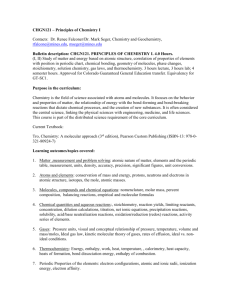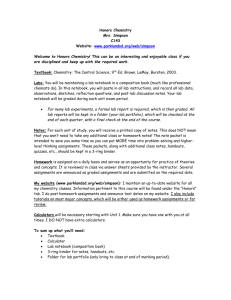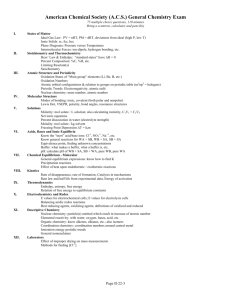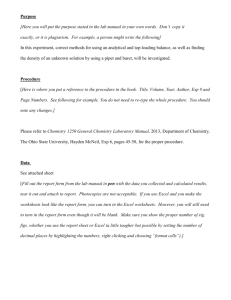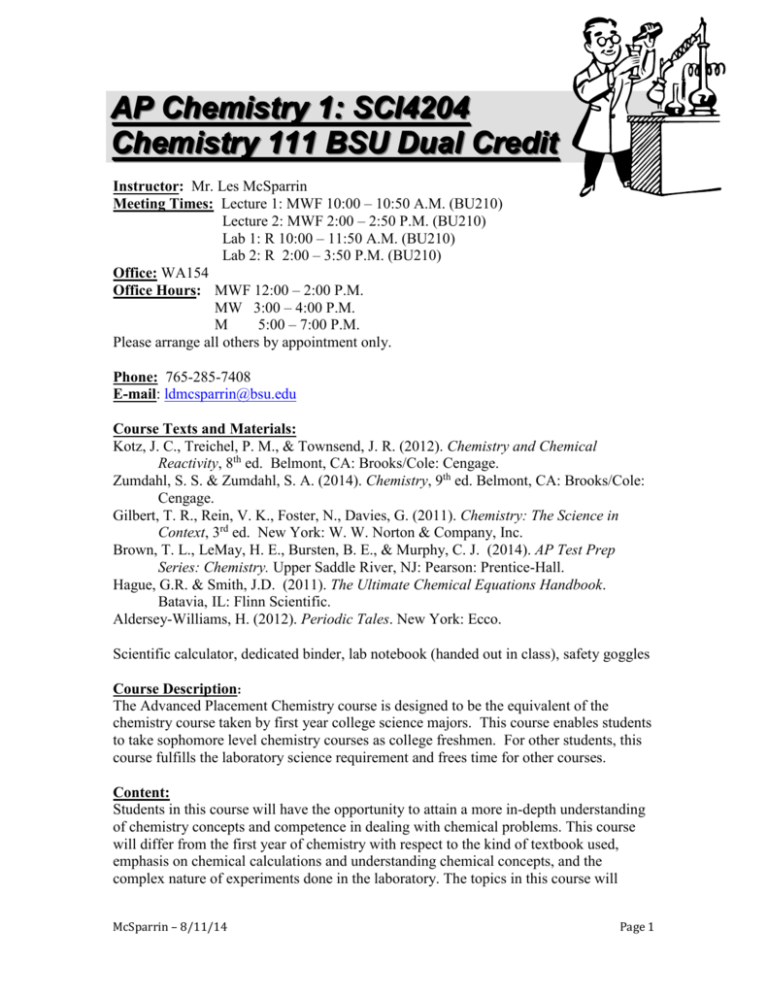
AP Chemistry 1: SCI4204
Chemistry 111 BSU Dual Credit
Instructor: Mr. Les McSparrin
Meeting Times: Lecture 1: MWF 10:00 – 10:50 A.M. (BU210)
Lecture 2: MWF 2:00 – 2:50 P.M. (BU210)
Lab 1: R 10:00 – 11:50 A.M. (BU210)
Lab 2: R 2:00 – 3:50 P.M. (BU210)
Office: WA154
Office Hours: MWF 12:00 – 2:00 P.M.
MW 3:00 – 4:00 P.M.
M
5:00 – 7:00 P.M.
Please arrange all others by appointment only.
Phone: 765-285-7408
E-mail: ldmcsparrin@bsu.edu
Course Texts and Materials:
Kotz, J. C., Treichel, P. M., & Townsend, J. R. (2012). Chemistry and Chemical
Reactivity, 8th ed. Belmont, CA: Brooks/Cole: Cengage.
Zumdahl, S. S. & Zumdahl, S. A. (2014). Chemistry, 9th ed. Belmont, CA: Brooks/Cole:
Cengage.
Gilbert, T. R., Rein, V. K., Foster, N., Davies, G. (2011). Chemistry: The Science in
Context, 3rd ed. New York: W. W. Norton & Company, Inc.
Brown, T. L., LeMay, H. E., Bursten, B. E., & Murphy, C. J. (2014). AP Test Prep
Series: Chemistry. Upper Saddle River, NJ: Pearson: Prentice-Hall.
Hague, G.R. & Smith, J.D. (2011). The Ultimate Chemical Equations Handbook.
Batavia, IL: Flinn Scientific.
Aldersey-Williams, H. (2012). Periodic Tales. New York: Ecco.
Scientific calculator, dedicated binder, lab notebook (handed out in class), safety goggles
Course Description:
The Advanced Placement Chemistry course is designed to be the equivalent of the
chemistry course taken by first year college science majors. This course enables students
to take sophomore level chemistry courses as college freshmen. For other students, this
course fulfills the laboratory science requirement and frees time for other courses.
Content:
Students in this course will have the opportunity to attain a more in-depth understanding
of chemistry concepts and competence in dealing with chemical problems. This course
will differ from the first year of chemistry with respect to the kind of textbook used,
emphasis on chemical calculations and understanding chemical concepts, and the
complex nature of experiments done in the laboratory. The topics in this course will
McSparrin – 8/11/14
Page 1
include: the structure of matter (atomic theory, chemical bonding, and nuclear chemistry),
reaction types, stoichiometry, and redox chemistry. Problem solving; higher-order
thinking; the scientific method; the use of scientific literature; qualitative analysis;
quantitative techniques; data collection, manipulation, and analysis; and exposure to
instrumentation will be the focus of the laboratory experience.
Guidelines for Success
1. Attendance is vital to your understanding of the subject material in this class. Often
times, just reading the book is not enough. I feel that each of you needs to be present
during each class meeting to take part in the classroom discussions and activities.
Make certain that you are clearly aware of the attendance policy here at the Indiana
Academy.
2. Read your book. Be certain to read the text and any other resources provided
before you come to class. Although I will be discussing many of the highlights
found in the text in some detail, reading the material in advance will aid you in
learning. Use the textbook as a tool for understanding.
Read with purpose. Be an active reader. Note carefully all bold-faced or italicized
words.
Sometimes it helps to read a portion of a chapter once for general understanding,
view the online lecture and hear my explanation of the material, and then read it a
second time for details and writing notes. It may help to read out loud. Hearing
something reinforces the information in a very positive way and helps you
remember.
3. Be prompt in completing assignments. There is a penalty of 20% per day on all late
assignments and laboratories. No assignments will be accepted after 1 day late. NO
EXCEPTIONS! Never slide assignments under my office door; deliver all late
assignments to me personally.
4. I expect each and every one of you to participate in the classroom. This will allow
you to gain points. Keep in mind….I need some justification to “bump up” a
borderline grade. If you participate in class in a meaningful way on a regular basis,
this will influence my decision. Participation in laboratory is mandatory.
5. Throughout the semester, I will make written assignments from material which you
will find in the library, in journals, or on the Internet. Take these literature review
assignments seriously since they count as 5% of your semester grade (1/2 a letter
grade).
6. In class, take careful notes with purpose. Do not attempt to write down everything
that is said or to write information in complete sentences. Your notes should be
short, concise, with only key words and phrases recorded. More detailed definitions
McSparrin – 8/11/14
Page 2
and explanations are in your textbook. Copy down all sample problems we complete
during class. The most important thing you can do in class is to listen and ask
meaningful questions.
7. Review your notes each day after school. Add brief comments to your notes from
class discussions. Review your notes again, reading them out loud if possible. Do
not choose one night before an examination and study for long hours. This is only
counterproductive, as you will remember the first five minutes and the last five
minutes, but little or nothing in between. Instead, study often. Take breaks every
15-20 minutes to allow you to return to the material with more attention.
8. Use a highlighter while you study. Highlight the information or practice problems in
your notes that you don’t understand. Ask questions about these points of confusion
during class and/or during my office hours. Your questions and the discussions that
follow during class time will help other students.
9. Learning should not be a competitive exercise. You can best help yourself by
helping others. Form study groups or try to tutor a student who seems to be having
difficulty. While attempting to explain concepts to others, you will become aware of
your own depth of understanding and those areas you need to study further.
11. Remember these words of wisdom from Chinese proverbs …
“Failing to plan is planning to fail.”
“Teachers open the door. You enter by yourself.”
“I hear, and I forgot. I see, and I remember. I do, and I understand.”
" To merely know is nothing compared to being interested to
know, being interested to know is nothing compared to deriving joy
from learning it." - Confucius
and the famous Vince Lombardi quote:
[The] “Dictionary is the only place that success comes before work.
Hard work is the price we must pay for success. I think you can
accomplish anything if you're willing to pay the price.”
McSparrin – 8/11/14
Page 3
Grading Policy
Your semester grade will be calculated using the following weighted average. I
have designed this method of grade calculation to give you credit for all the work you do
for class and not just base your grade on examinations and quizzes.
Examinations and Quizzes ………………………………………………………… 60 %
Laboratory Performance, Reports, and Notebook …….…………………………... 25 %
Assignments and Class Notebook ..……………………………………………….. 10 %
Written Projects, Internet Assignments, Literature Reviews ……………………..
5%
a.) Participation – Participation points will be assigned to those students who write out their answers to
problems on the board.
b.) Safety – I will be looking for safe laboratory procedures. Students who have been safe and careful in
the laboratory will be rewarded. Unsafe behavior will result in loss of privileges.
Grading Scale
Percentage
93.00 – 100
90.00 – 92.99
87.00 – 89.99
83.00 – 86.99
80.00 – 82.99
77.00 – 79.99
70.00 – 76.99
65.00 – 69.00
≤64.99
Grade
A
AB+
B
BC+
C
CD*
Note: I reserve the right to make positive adjustments to borderline grades at the end of
each semester for those students who show motivation and interest in the subject. This is
at my discretion and is non-negotiable. Don’t assume you are entitled to this privilege.
McSparrin – 8/11/14
Page 4
Examinations and Quizzes
You will receive take-home examinations for each unit covered in the course. In
addition, there will be a mid-term examination and a cumulative final. Plus, expect a
brief quiz at any time during the week at the beginning of class.
Materials
1. It will be necessary for you to have a scientific calculator now if you don’t have one.
It will be difficult for you to do the calculations required in this course without one.
We will be doing a great deal of graphing in this class. Therefore, it would be an
asset to have a graphing calculator. My suggestion would be the TI-84-Plus Silver
edition if you are taking AP Calculus concurrently. It has a Periodic Table
application that would be very beneficial.
2. You will be required to maintain a notebook for this course. You will need a large
3-ring binder. It should be divided into 4 sections:
1.) class notes
assignments and handouts
laboratories
written projects and literature reviews
3. I suggest that you have a laboratory coat for protection of your skin and clothing.
We work with many toxic/corrosive agents. So, prudent practices are a must.
4. Each student is required to have a pair of safety goggles that meet the ANSI Z87+
standards.
5. An NCR lab notebook is required and will be handed out the first lab period. No
student will be permitted into the laboratory without a completed lab notebook. You
will be expected to write all of your lab reports in the notebook, and you will be
turning in the NCR page to me for scoring purposes. The lab notebook is the key to
getting AP credit at universities. Chemistry departments will expect to see evidence
that you had performed a variety of laboratories surveying general chemistry topics.
General Classroom Guidelines and Procedures
1. Be in your seat and have the necessary items for class before class begins.
Necessary items would include: pencils/pens, notebook, textbook, paper, calculator,
and laptop. I do not lend writing utensils, calculators, or paper.
2. Talking while others have the floor is rude and disrespectful. I will afford you
100 % of my respect, unless you provide me with an instance to feel otherwise.
3. No food, gum, and/or drinks are to be brought into a science classroom.
McSparrin – 8/11/14
Page 5
4. Laptops are to be in use when necessary. Otherwise, they should be shut down and
in your backpack.
5. No cell phones are to be “on” or used during class time. Cell phones will be
confiscated from anyone texting during class. If I confiscate a cell phone, you will
be required to have a meeting with me and your SLC in order to have it returned.
Subsequent confiscations will result in a meeting with me and Dr. Smith.
6. Purses and backpacks are to be left under your desk to reduce clutter in the
laboratory.
7. Tardy to class is unacceptable, especially on an habitual basis. After 5 minutes, you
will be considered absent and will be marked as such. You will receive a warning
for the first tardy to class. Subsequent instances of being tardy will be marked as
class absences.
8. Laying your head down and/or sleeping in class will result in a class absence being
recorded, regardless of your reason or excuse.
Makeup Work
1. Here at Indiana Academy, much higher expectations are placed upon you than you
may be accustomed. If you miss a class, it is your responsibility to consult
Blackboard and other classmates to find out what information you have missed. I
will make every attempt to keep Blackboard current with handouts given in class.
2. You may have the length of time equal to the length of your absence to make up any
missed work. For example, if you miss class one day, you may have one day to
make up any missed work.
3. Being absent from class does not excuse you from assignments which were due. If
you are ill and cannot attend class, it is your responsibility to either send your
assignment with a classmate or to send it via an e-mail attachment before the
beginning of class. E-mail attachments sent after the beginning of class will be
considered to be late and will receive late credit.
4. In the event you miss laboratory for an excused reason, you must arrange a makeup
lab with me as soon as possible. All missed laboratories must be made up within
one week of the missed laboratory session.
McSparrin – 8/11/14
Page 6
Academic Integrity
As stated in the student handbook, “All members of the Academy community have a
responsibility to promote the highest possible academic integrity. Students should always
remember that the Academy Code of Conduct includes a commitment to ‘integrity in all
things.’”
Collaboration on homework is acceptable. However, every effort should be made to
make sure you write homework answers in your own words. Clearly, collaboration on
examinations and quizzes is unacceptable.
You will be assigned a laboratory partner. You and your partner will work on the
collection of data cooperatively. However, treatment of the data and all graphs and
answers to review questions should be your own, unique creation. In certain cases, it will
be stated to share data and/or printouts of graphs. You will be informed by me when that
will be acceptable.
Each group will be required to record their data with the instructor before leaving the
laboratory. Use of any data other than that which was collected by your group during the
laboratory session is dishonest and a violation of academic integrity.
Plagiarism (using someone else’s academic ideas without citing that person),
copying homework (even if it is one answer), and/or cheating on quizzes or examinations
are clear violations of the Student Academic Integrity policy. As a result, any involved
students will be reported to the office of Academic Affairs. Be aware that the person
who allows his/her work to be copied and/or plagiarized will also be reported and face
punitive actions.
Statement Regarding Possible Disability:
If you need adaptations or accommodations because of a disability, if you have
emergency medical information to share with me, or if you need special arrangements in
case the building must be evacuated, please make an appointment with me as soon as
possible.
McSparrin – 8/11/14
Page 7
Course Outline
Unit
1
1LAB
Topics and Labs
IQ = Inquiry
TL = Technique Lab
EX = Extension Lab
Introduction/Chemistry Review
a.) Matter and Its Classification
b.) Elements, Compounds, and Mixtures
c.) Physical and Chemical Properties and
Changes
d.) Units of Measurement
e.) Precision and Accuracy
f.) Error and Standard Deviation
g.) Significant Figures
h.) Dimensional Analysis
i.) Graphing
j.) Atomic Structure
k.) Atomic Number and Atomic Mass
l.) Isotopes
m.) Basics of the Periodic Table
n.) Modeling the Molecular World
o.) Nomenclature and Formulas of Ionic
Compounds
p.) Nomenclature and Formulas of
Molecular Compounds
Exp. 1: Working in the Chemistry Lab (TL)
Students review safety rules and the proper
use of equipment in the chemistry lab.
Exp. 2: Density and Error Analysis (IQ/TL)
Students determine the density of regularly
shaped solids, irregularly shaped solids, and
various liquids, perform an error analysis,
and use a calibration curve to determine
the % concentration of an unknown
EtOH/H2O mixture.
Exp. 3: Separation of Dyes and an Ionic
Mixture (IQ/TL)
Students use paper chromatography
techniques to separate an ionic mixture.
This lab will incorporate aspects of College
Board Investigation 5: Sticky Question:
How Do You Separate Molecules That Are
Attracted to One Another?
McSparrin – 8/11/14
Chapter Readings
Kotz/Treichel Text
1-2.8
Including the “Let’s
Review” section
Page 8
2
Stoichiometry
a.) Mole Concept
b.) Atomic/Molar Mass
c.) Percent Composition and Hydrates
d.) Empirical/Molecular Formula
e.) Chemical Equations and Balancing
f.) Reaction Stoichiometry/Limiting Reagent
g.) Percent Yield
h.) Combustion Analysis
2LAB
Exp. 4: Determination of Avogadro’s
Number (IQ)
Students use a monolayer of stearic acid or
oleic acid to experimentally determine
Avogadro’s number.
Exp. 5: What is a Hydrate? (IQ)
Students determine the characteristic
properties of a hydrate and identify an
unknown hydrate by determining its
percent water.
Exp. 6: Determination of the Formula of a
Compound (IQ)
Students determine the empirical formula
of a designated compound.
3
Chemical Reactions and Solution
Stoichiometry
a.) Physical Properties of Water
b.) Aqueous Solutions and Dissociation
c.) Electrolytes and Non-electrolytes
d.) Types of Chemical Reactions
e.) Solubility Rules
f.) Precipitation Reactions
g.) Net Ionic Equations
h.) Intro to Acids and Bases and pH
i.) REDOX Chemistry
j.) Basic Galvanic Cells
k.) Solution Concentrations and Dilutions
l.) Stoichiometry of Aqueous Solutions
McSparrin – 8/11/14
2.8 – 2.11
3.1 – 3.2
4.1 – 4.4
3.3 – 3.8
4.6
20.1 – 20.4
4.5, 4.7
Page 9
3LAB
Exp. 7: Types of Reactions (IQ)
Students perform various types of reactions
and determine the type of reaction.
Exp. 8: Acid/Base Titration (TL)
Students standardize a sodium hydroxide
solution and then determine the
concentration of an unknown acid
Exp. 9: Redox Titration (TL)
Students standardize a permanganate
solution and then determine the %H2O2 in
commercial hydrogen peroxide and the %Fe
in an unknown compound. This lab will
incorporate aspects of College Board
Investigation 8: How Can We Determine
the Actual Percentage H2O2 in a Drugstore
Bottle of Hydrogen Peroxide?
PROJ1
Lab Project 1 (IQ/EX): Students perform a
gravimetric analysis and an EDTA titration
to determine the hardness of Muncie, IN
water. This project will incorporate aspects
of College Board’s Investigation 3: What
Makes Hard Water Hard? (IQ/EX)
MT
4
MIDTERM: TBA
Atomic Structure and Periodicity
a.) Early Development of the Atomic
Theory: Democritus, Lavoisier, Dalton,
Curie, Rutherford, Thomson, Chadwick
b.) Radioactivity and Radioactive Decay
c.) Stability of Atomic Nuclei
d.) Fission and Fusion
e.) Applications of Nuclear Chemistry
f.) Electromagnetic Radiation
g.) Quantization: Planck, Einstein, Energy,
and photons
h.) Atomic Spectra and the Bohr Model
i.) Quantum Mechanical Model of the Atom
j.) Orbitals/Quantum Numbers/Electron
Configuration
k.) History and Design of the Periodic Table
l.) Periodic Trends: atomic radii, ionization
energy, electron affinity, electronegativity
McSparrin – 8/11/14
Cumulative
23.1 – 23.3
23.5 – 23.9
6 (all)
7 (all)
Including
“Milestones….”at
the end of Chap 7
Page 10
4LAB
Exp. 10: Atomic Spectra (IQ)
Students examine the spectra emitted from
various gaseous elements and perform the
quantum calculations for hydrogen.
Exp. 11: Introduction to Spectroscopy (TL)
Students learn the proper use of a
spectrophotometer and determine the
concentration of an unknown Co2+ solution
using a calibration curve.
College Board: Investigation 2: How Can
Color Be Used to Determine the Mass
Percent of Copper in Brass? (IQ/EX)
Students will use spectroscopy to
determine the % copper in a brass sample.
5
Chemical Bonding
a.) Ionic Bonding: ionic sizes, Coulomb’s
Law
b.) Covalent Bonding: localized electron
model, Lewis structures, resonance,
exceptions to the octet rule
c.) Molecular Geometry/VSEPR/Polarity
d.) Hybridization/Delocalized Model
e.) Properties of the Transition Elements
f.) Coordination Compounds
g.) Coordination Compound Nomenclature
h.) Bonding in Coordination Compounds
i.) Color and Spectrochemical Series
5LAB
Exp.12: Chemical Bonding (IQ)
Students use molecular models to illustrate
the localized electron model.
Activity: Molecular Geometry with
Balloons (IQ) Students use balloons to
determine the molecular shapes and bond
angles of various molecules.
Lab Project 2: Green Crystal Lab
Students synthesize a green oxalate
coordination complex of iron. The students
will determine the % H2O, % Fe and %
oxalate in the compound.
SEMESTER FINAL: TBA
FINAL
McSparrin – 8/11/14
8.1 – 8.8
9.1 – 9.2
22.1, 22.3 – 22.6
Cumulative
Page 11
McSparrin – 8/11/14
Page 12

